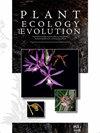Johansenicoccus eremophilus gen. et sp. nov., a novel evolutionary lineage in Chlorophyceae with unusual genomic features
IF 1.3
4区 生物学
Q3 PLANT SCIENCES
引用次数: 0
Abstract
Background – Green algae are a diverse group of photosynthetic eukaryotes, yet are still vastly understudied compared to land plants. For many years, green algae were characterized based on their morphology and life cycles. More recently, phylogenetic and genomic analyses have been added to the phycological toolkit for a better understanding of algal biodiversity and evolutionary history. Material and methods – A desert strain of green algae was isolated from Joshua Tree National Park (JTNP) in southern California as part of a larger biodiversity survey. The alga’s nuclear rRNA genes as well as the chloroplast genome were sequenced, annotated, and analysed in addition to a morphological assessment. Results – Morphologically this strain is especially similar to Pseudomuriella and Rotundella, and its lipid profile resembles that of other soil algae, but phylogenomic analyses demonstrate that it is a distinct evolutionary lineage in Chlorophyceae. The alga exhibits several unusual genomic features, the most remarkable being its highly derived yet apparently functional nuclear rRNA genes, 18S and 28S. Both genes are GC-rich and bear many compensatory base changes to maintain a similar secondary structure to that of other green algae. The chloroplast genome has a distinct gene order and repeat arrangement from other published green algal plastomes, but contains the expected genes and also provides phylogenetically informative data. Conclusion – We conclude that the strain be placed into a new species and genus in the class Chlorophyceae, and propose the name Johansenicoccus eremophilus for this new taxon. Johansenicoccus eremophilus exemplifies science’s insufficient understanding of the range of genomic variations among inconspicuous soil algae.eremophilus gen.et sp.nov.,一个具有特殊基因组特征的吊兰科新进化谱系
背景——绿藻是一种多样的光合真核生物,但与陆地植物相比,其研究仍然严重不足。多年来,人们根据绿藻的形态和生命周期对其进行了表征。最近,系统发育和基因组分析已被添加到藻类生态学工具包中,以更好地了解藻类生物多样性和进化史。材料和方法——作为更大规模生物多样性调查的一部分,从南加州约书亚树国家公园(JTNP)分离出一株沙漠绿藻。除了形态学评估外,还对藻类的核rRNA基因以及叶绿体基因组进行了测序、注释和分析。结果-从形态学上讲,该菌株与Pseudomuriella和Rotundella特别相似,其脂质图谱与其他土壤藻类相似,但系统发育分析表明,它是吊兰科中一个独特的进化谱系。这种藻类表现出几种不同寻常的基因组特征,最引人注目的是其高度衍生但功能明显的核rRNA基因18S和28S。这两个基因都富含GC,并具有许多补偿性碱基变化,以保持与其他绿藻相似的二级结构。叶绿体基因组具有与其他已发表的绿藻质体不同的基因顺序和重复排列,但包含预期的基因,也提供了系统发育信息数据。结论-我们得出结论,该菌株被归入绿藻纲中的一个新种和属,并为这个新的分类单元命名为埃雷莫菲氏Johansenicoccus。埃雷莫菲氏Johansenicoccus eremophilus是科学界对不起眼的土壤藻类基因组变异范围理解不足的例证。
本文章由计算机程序翻译,如有差异,请以英文原文为准。
求助全文
约1分钟内获得全文
求助全文
来源期刊

Plant Ecology and Evolution
PLANT SCIENCES-
CiteScore
2.20
自引率
9.10%
发文量
27
审稿时长
>12 weeks
期刊介绍:
Plant Ecology and Evolution is an international peer-reviewed journal devoted to ecology, phylogenetics and systematics of all ‘plant’ groups in the traditional sense (including algae, cyanobacteria, fungi, myxomycetes), also covering related fields.
The journal is published by Meise Botanic Garden and the Royal Botanical Society of Belgium.
 求助内容:
求助内容: 应助结果提醒方式:
应助结果提醒方式:


